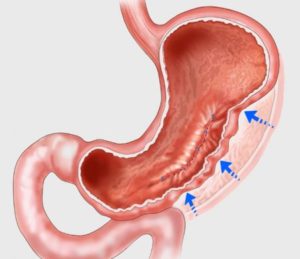Endoscopic Sleeve Gastroplasty
The aim of this procedure is similar to that of a gastric sleeve, with the only difference being that here, the stomach’s size is reduced using sutures (stitches) rather than staplers. In addition, in an Endoscopic Sleeve Gastroplasty, no part of the stomach is actually removed; it is merely designed, folding inwards. Usually patients lose, on average, 18% to 20% of their body weight after one year.
The effect of reducing the size of your stomach is two-fold.
1- Since it holds less, you eat less and,
2- Changes in gut hormones cause slow gastric emptying and longer satiety.
Some of the advantages are that no incisions are required, you won’t need to stay in the hospital overnight, and pain and risk is minimal. Our bariatric surgeon will be able to advise you whether this is the best option for you.
How it works
An endoscope is a long, flexible device that passes through your mouth and esophagus to enter the stomach. To create the gastric sleeve, a suturing (stitching) device is mounted onto the endoscope. Our surgeon will use the OverStitch™ Endoscopic Suturing System, which allows him to place full-thickness sutures. No portion of the stomach will be removed. Instead, he will sew the inside of the stomach, drawing the lateral edges together, effectively reducing its size to roughly that of a banana.
Risks and Complications
Like other weight-loss procedures, endoscopic sleeve gastroplasty requires commitment to a healthier lifestyle. We have a multidisciplinary team including dietitians, psychologists and physiotherapists, to help you make permanent healthy changes to your diet and activity levels. Unlike other surgical options, our surgeon will not remove any part of your stomach, therefore risks and complicates are rare.

